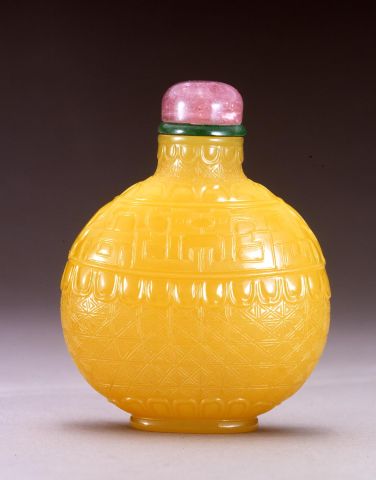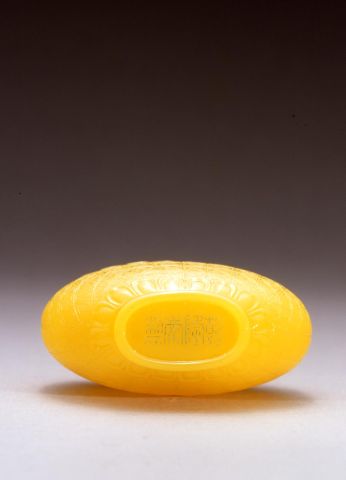

Bottle ID: 00163
YELLOW IMPERIAL, CARVED W/DRAGONS & MARK
Date: 1736-1795
Height: 57 mm
Glass, of flattened rounded form, opaque bright yellow tone, the lower body incised with cell diaper patterns between molded petal lappet borders, with a band of confronted archaistic dragons on the shoulders interrupted by a pair of bovine mask handles, all below further diapers bordered by lappet bands on the neck; the base with an incised Qianlong nianzhi mark in Seal script and of the period.
Imperial, attributed to the Palace Workshops, Beijing.
Similar Examples:
Stevens, Bob C. The Collector's Book of Snuff Bottles, 1976, p. 68, no. 186.
Moss, Hugh M. [ed.] Chinese Snuff Bottles: 5, 1969, p. 25, fig. 8.
Moss, Hugh, Victor Graham and Ka Bo Tsang. A Treasury of Chinese Snuff Bottles - The Mary and George Bloch Collection, 2002, Vol. 5, Part 2, pp. 344-346, no. 828.
Sotheby's, Los Angeles, October 31, 1984, lot 51, Collection of Alice B. McReynolds, Part I.
Provenance:
Clare Lawrence Ltd.
Christie's, New York, November 11, 1992, lot 364
Mr. Chu, London
Christie's, London, October 12, 1987, lot 73
Edmund F. Dwyer
Katherine Kitchin
Exhibited:
Annual Convention ICSBS Toronto, October 2007
Los Angeles County Museum of Art, October-November 1984
Published:
JICSBS, Autumn 2006, Front Cover
JICSBS, Winter 1992, p. 38, fig. 6
JICSBS, Autumn 1987, p. 26, fig. 1
Paula Gasparello, Chinese Art Auction, 1987, p. 180
Gemological Institute of America Alumni Association, In Focus, Winter 1985/6, Front Cover
JICSBS, Summer 1984, Front Cover
Very few glass bottles bear authentic "Imperial" reign marks; with even fewer of these being of a bright opaque yellow glass such as this example. Theoretically, "Imperial yellow" glass snuff bottles hardly need base marks since their color alone should allow for Imperial identification. However, the fact that one is present adds to its highly Imperial nature. For whatever reason, a number of yellow glass bottles and other glass objects appear with Qianlong nianzhi marks (made in the Qianlong period) and more rarely Qianlong yuzhi marks (by order of the Qianlong Emperor). On glass, these marks are usually incised and appear both in Seal script and regular script. Imperial marks are ranked in a specific and hierarchical way. Marks such as Yuwan (Imperial plaything), Yuyong (Imperial use) and Shangwan (treasured plaything) denote personal usage by the Emperor, as do specific Imperial hall marks such as Shende Tang. Yuzhi marks seem to indicate experimental groups of wares where there is Imperial interest in their manufacture.
Opaque yellow was a color reserved for the use of the Emperor and his extended family (including the royal princesses, princes and their concubines). Although snuff bottles were not included as part of the official "Imperial" regulations, as ceramics and textiles were, it is likely that the same restrictions would apply to the use of opaque yellow glass bottles of specific yellow tones. The design, carved in low relief on the bottle, is typical of the Palace Workshops output, harking back to the archaism of earlier dynasties, where similar designs appeared on bronze vessels such as dings and gus. This opaque yellow bottle is exquisitely made and may have been destined for the pocket or sleeve of one of the Imperial princes or even for the Emperor himself.

 English
English 中文
中文